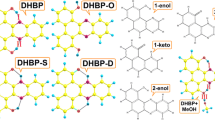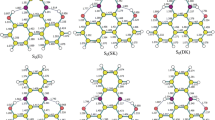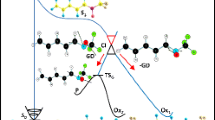Abstract
DFT calculations on the photoisomerization of hydrazones of 1,2,4-oxadiazole derivatives to 1,2,5-triazoles have been performed showing that the reaction occurred through the first excited singlet state. The Z isomer gave the reaction through a hydrogen atom transfer of the hydrazonic nitrogen atom to the nitrogen atom in four position on the oxadiazole ring. In this case, the isomerization was a concerted reaction. The E isomer could undergo the same reaction. However, it could not be a concerted reaction but required the presence of a ring opening intermediate.
Similar content being viewed by others
Avoid common mistakes on your manuscript.
1 Introduction
The photoisomerization of pentatomic heterocyclic compounds is one of the most studied photochemical reaction allowing to obtain some significant synthetic processes [1,2,3].
Some years ago, the photochemical isomerization of 1,2,4-oxadiazole derivatives 1 has been reported to give the corresponding triazoles 2 (Scheme 1) [4]. When the reaction was performed in the presence of Ry(bpy)2Cl2, a new photoisomerization to the triazole 3 was observed (Scheme 1) [5]. While a theoretical explanation of the reaction 1 → 3 has been reported [6], no hypothesis is available on the possible mechanism of the photochemical reaction 1 → 2. The described reaction is the photochemical version of the thermal Boulton–Katritzky rearrangement (Scheme 2) [7, 8].
The Boulton-Katritzky reaction can occur in acid catalyzed, base catalyzed and uncatalyzed conditions and seems to involve a SNi process requiring a quasi-aromatic transition state depicted in the Fig. 1 [9, 10]. In the proposed scheme the hydrazonic nitrogen atom attacks the oxadiazole ring inducing the observed ring cleavage. It could be interesting to verify if the same type of mechanism works when the reaction is photochemically performed. However, recently we found that, in the photochemical isomerization of 2-furylidenetetralone (Scheme 3), where a quasi-aromatic transition state similar to that proposed for the Boulton–Katritzky rearrangement could be considered, this type of transition state was not present [11]. Furthermore, the reaction occurred through the attack of the oxygen atom of the carbonyl group on the furan ring, showing a behavior quite similar to that described for the Boulton–Katritzky rearrangement.
It is difficult to use the mechanism proposed for the Boulton–Katritzky rearrangement for the photochemical version of this reaction: both Z and E isomers are reactive in the photochemical reaction while the transition state calculated in the thermal reaction can be obtained only using the Z isomer. Furthermore, Z,E photoisomerization did not occur in the tested substrates, and, finally, the yields of the 1,2,4-triazole derivative are higher when the E isomer is used in the photochemical reaction (Scheme 4) [4].
On the basis of these results, we decided to perform a DFT study on E and Z isomer of 1 to identify the mechanism of the described reaction and to verify two hypotheses, a. if a quasi-aromatic transition state is involved in the reaction as in thermal Boulton–Katriztky reaction, b. if the reaction occurs through the attack of the hydrazonic nitrogen atom to the oxadiazole ring.
2 Results and discussion
In this study the photochemical behavior of 1 has been studied. The computational work has been conducted at DFT level of theory using B3LYP/6-311G * (d,p) on Gaussian09. The Z isomer of the 1,2,4-oxadiazole derivative 1 showed a calculated absorption at λ = 410 nm (in dioxane Z-1 showed an absorption at λ = 366 nm (log ε = 4.22) [12]), corresponding to an electronic transition from orbital 89 (NHOMO) to orbital 91 (LUMO). This way, an excited singlet state with an energy of 291 kJ mol−1 was obtained. The E isomer did not show a stability comparable to that of the Z isomer. It showed an energy higher for 20 kJ mol−1. This difference is due to the fact that one of the phenyl groups present on the molecule cannot be planar and conjugated with the rest of the molecule. The structure of the E isomer of 1 is reported in Fig. 2.
The E isomer of 1 showed a calculated absorption at λ = 401 nm (E-1 showed an absorption in dioxane at 335 nm (log ε = 4.31) [12]). Also, in this case, the observed absorption corresponds to an electronic transition from the NHOMO to the LUMO orbital of the molecule and allowed to obtain an excited singlet state at 318 kJ mol−1 (Fig. 3). The above-described situation does not allow the Z → E isomerization while the E → Z isomerization is possible.
Both E and Z isomers of 1 allowed the formation of the same triplet state because the geometry of the double bond is lost (Fig. 4). The energy of this triplet state was determined at 177 kJ mol−1 (Fig. 3). The triplet state cannot be responsible of the observed reaction (see below) and can be deactivated to give the starting materials.
The conversion of 1 to 2 is a photoisomerization of a pentaatomic heterocyclic compound. The photoisomerization of this type of compounds has been the object of an intense research work in the past [1,2,3]. Most of pentaatomic heterocyclic compounds gave the corresponding isomers through the formation of a ring opening process, or through the formation of a Dewar isomer. The possible scheme of these reaction is described in Scheme 5.
We tested the possible formation of ring opening biradical of 1, such as the biradical 4 reported in the reaction A of the Scheme 5, the formation of the ring contracted intermediate, such as 5 reported in the reaction A of the Scheme 5, and the formation of the Dewar isomer of 1, as 6 in the reaction B of the Scheme 5. All those species showed a very high energy and cannot be obtained starting from the excited states of 1. However, testing the possible reactivity of the Z isomer of 1, we found that a simple 1,5-HAT (hydrogen atom transfer) process can allow the transformation [13]. The excited singlet state of Z-1, if we impose the transfer of the hydrogen atom on the hydrazone to the nitrogen atom in four position on the 1,2,4-oxadiazole ring, allowed the direct transformation of Z-1 into 2 (Fig. 3). The reaction occurred through the formation of a transition state at 185 kJ mol−1 (Fig. 5). It is a late transition state where the triazole ring is formed and the O–N bond in the oxadiazole ring is broken. The hydrogen atom is bridged between the nitrogen atom in the oxadiazole and that in the final triazole.
The E-isomer can give the same reaction via a photochemical trans–cis isomerization reaction to give the corresponding reactive Z isomer. However, the singlet excited state of E-1 can be converted directly into the triazole derivative though the same reaction reported above. A hydrogen atom transfer can allow the formation of a ring opening product 4, where the shift of the hydrogen atom induced the ring opening of the oxadiazole (Figs. 4 and 6, Scheme 6).
The intermediate 4 can be converted, through a transition state at 159 kJ mol−1 (ST2, Figs. 4 and 7), into the triazole (Scheme 6).
The observed higher yields obtained when the E isomer is used could be explained considering that i. the Z isomer of 1 has only one way to react because the Z → E isomerization cannot be present (the excited singlet state of the E isomer is higher in energy than the Z isomer); ii. the singlet excited state of the E isomer of 1, on the contrary, can interconvert into the triazole through the formation of the intermediate 4, and can give the Z isomer through the photoisomerization and then, follows the isomerization route of the Z isomer; iii. The intersystem crossing quantum yields of the conversion of the excited singlet states of Z and E isomer of 1 is not known and it can determine the efficiency of the isomerization processes.
The triplet state of 1 cannot give the same reaction. The triplet state of 1 can give two hydrogen atom transfer processes. The first was a 1,3-HAT process to give the diazocompound 5 (Scheme 7) [14, 15], while the second was a 1,5-HAT process to give the oxadiazole derivative 6 (Scheme 7). Both 5 and 6 showed an energy higher than that of the triplet state (at 203 kJ mol−1 for 5 and at 255 kJ mol−1 for 6) showing that these processes cannot be present in the photoisomerization.
In conclusion, the described photoisomerization of E- and Z isomers of 1 can occur in two different processes involving the first excited singlet state. In the case of the Z isomer, the process is concerted, and the 1,5-HAT process allowed the formation of the triazole without the formation of intermediates, while, in the case of the E isomer, the isomerization occurs also in this case through a 1,5-HAT process but with the formation of an open intermediate species.
Furthermore, we have shown that the photochemical version of the Boulton–Katritzky rearrangement does not occur through the formation of a quasi-aromatic transition state, and that the reaction does not require the attack of hydrazonic nitrogen atom to the oxadiazole ring to occur, while the driving force of the reaction is a hydrogen shift process from the hydrazone to the oxadiazole ring.
3 Materials and methods
Gaussian09 has been used for the discussions about the computed geometries [16]. All the computations were based on the Density Functional Theory (DFT) [17] and Time-Dependent DFT (TD-DFT) [18, 19] using the B3LYP hybrid xc functional [20]. Geometry optimizations and TD-DFT results from the Gaussian09 program have been obtained at the B3LYP/6-311G+(d,p) level of approximation. Geometry optimizations were performed with default settings on geometry convergence (gradients and displacements), integration grid and electronic density (SCF) convergence. Redundant coordinates were used for the geometry optimization as produced by the Gaussian09 program. Analytical evaluation of the energy second derivative matrix w.r.t. Cartesian coordinates (Hessian matrix) at the B3LYP/6-311G+(d,p) level of approximation confirmed the nature of minima on the energy surface points associated to the optimized structures. The transition states were calculated in S0 state.
Availability of data and material
All data generated or analyzed during this study are included in this published article (and its supplementary information files).
References
Pavlik, J. W. (2004). Photoisomerization of some nitrogen-containing heteroaromatic compounds. In W. Horspool & F. Lenci (Eds.), CRC Handbook of organic photochemistry and photobiology. (pp. 97–122). Boca Raton: CRC Press.
Pavlik, J. W. (2004). Photochemistry of thiazoles, isothiazoles, and 1,2,4-thiadiazoles. In W. Horspool & F. Lenci (Eds.), CRC Handbook of organic photochemistry and photobiology. (pp. 98–114). Boca Raton: CRC Press.
D’Auria, M. (2011). Photochemical and photophysical behavior of thiophene. Advances in Heterocyclic Chemistry, 104, 127–390.
D’Auria, M., Frenna, V., Marullo, S., Racioppi, R., Spinelli, D., & Viggiani, L. (2012). Photochemical isomerization of aryl hydrazones of 1,2,4-oxadiazole derivatives into the corresponding triazoles. Photochemical and Photobiological Sciences, 11, 1383–1388.
D’Auria, M., Frenna, V., Monari, M., Palumbo-Piccionello, A., Racioppi, R., Spinelli, D., & Viggiani, L. (2015). Ru(bpy)2Cl2: a catalyst able to shift the course of the photorearrangement in the Boulton-Katritzky reaction. Tetrahedron Letters, 56, 6598–6601.
D’Auria, M. (2018). A new photoisomerization of 1,2,4-oxadiazoles. A computational study. Letters in Organic Chemistry, 15, 1021–1024.
Boulton, A. J., Katritzky, A. R., & Majid-Hamid, A. (1967). Heterocyclic rearrangements. Part X. A generalized monocyclic rearrangement. Journal of Chemical Society C. https://doi.org/10.1039/J39670002005
Vivona, N., Buscemi, S., Frenna, V., & Cusmano, G. (1993). Ring transformations of five-membered heterocycles. Advances in Heterocyclic Chemistry, 56, 627–638.
Spinelli, D., Corrao, A., Frenna, V., Vivona, N., Ruccia, M., & Cusmano, G. (1976). Mononuclear heterocyclic rearrangment. Note I. Kinetic study of the rearrangement of the phenylhydrazone of 3-benzoyl-5-phenyl-1,2,4-ozadiazole into 2,5-diphenyl-4-benzoylamino-1,2,3-triazole. Journal of Heterocyclic Chemistry, 13, 357–360.
Bottoni, A., Frenna, V., Lanza, C. Z., Macaluso, G., & Spinelli, D. (2004). Convergent results from experimental and theoretical DFT studies of the intramolecular rearrangment of Z-hydrazones of 3-acyl-1,2,4-oxadiazoles. Journal of Physical Chemistry A, 108, 1731–1740.
Dauria, M. (2020). The photochemical isomerization of 2-furylidenetetralone. Journal of Photochemistry and Photobiology, A: Chemistry, 390, 112332.
Vivona, N., Ruccia, M., Frenna, V., & Spinelli, D. (1980). Mononuclear heterocyclic rearrangements. Part 4 (1). Synthesis and characterization of the E-isomer phenylhydrazone of 3-benzoyl-5-phenyl-1,2,4-oxadiazole. Journal of Heterocyclic Chemistry, 17, 401–402.
Lefebvre, C., Fortier, L., & Hoffmann, N. (2020). Photochemical rearrangements in heterocyclic chemistry. European Journal of Organic Chemistry. https://doi.org/10.1002/ejoc.201901190
Spialter, L., & Untereiner, G. L. (1967). Synthesis of azo compounds by rearrangement of hydrazones. U. S. Patent 3,350,385 (October 31, 1967).
Gallagher, G. (1978). Oxidation of hydrazones to the corresponding diazo compounds. U. S. Patent 4,083,837 (April 11, 1978).
Gaussian 09, Revision A.1, Frisch, M. J., Trucks, G. W., Schlegel, H. B., Scuseria, G. E., Robb, M. A., Cheeseman, J. R., Scalmani, G., Barone, V., Mennucci, B., Petersson, G. A., Nakatsuji, H., Caricato, M., Li, X., Hratchian, H. P., Izmaylov, A. F., Bloino, J., Zheng, G., Sonnenberg, J. L., Hada, M., Ehara, M., Toyota, K., Fukuda, R., Hasegawa, J., Ishida, M., Nakajima, T., Honda. Y., Kitao. O., Nakai, H., Vreven, T., Montgomery Jr., J. A., Peralta, J. E., Ogliaro, F., Bearpark, M., Heyd, J. J., Brothers, E., Kudin, K. N., Staroverov, V. N., Kobayashi, R., Normand, J., Raghavachari, K., Rendell, A., Burant, J. C., Iyengar, S. S., Tomasi, J., Cossi, M., Rega, N., Millam, J. M., Klene, M., Knox, J. E., Cross, J. B., Bakken, V., Adamo, C., Jaramillo, J., Gomperts, R., Stratmann, R. E., Yazyev, O., Austin, A. J., Cammi, R., Pomelli, C., Ochterski, J. W., Martin, R. L., Morokuma, K., Zakrzewski, V. G., Voth, G. A., Salvador, P., Dannenberg, J. J., Dapprich, S., Daniels, A. D., Farkas, O., Foresman, J. B., Ortiz, J. V., Cioslowski, J., & Fox, D. J. (2009). Gaussian, Inc., Wallingford CT.
Parr, R. G., & Yang, W. (1989). Density functional theory of atoms and molecules. Oxford: Oxford University Press.
Casida, M. E. (1995). Time-dependent density-functional response theory for molecules. In D. P. Chong (Ed.), Recent advances in density functional methods. (Vol. 1, pp. 155–192). Singapore: World Scientific.
Casida, M. E., Jamorski, C., Casida, K. C., & Salahub, D. R. (1998). Molecular excitation energies to high-lying bound states from time-dependent density-functional response theory: Characterization and correction of the time-dependent local density approximation ionization threshold. Journal of Chemical Physics, 108, 4439–4449.
Becke, A. D. (1993). Molecular excitation energies to high-lying bound states from time-dependent density-functional response theory: Characterization and correction of the time-dependent local density approximation ionization threshold. Journal of Chemical Physics, 98, 5648–5652.
Funding
Open access funding provided by Università degli Studi della Basilicata within the CRUI-CARE Agreement. The author did not receive support from any organization for the submitted work.
Author information
Authors and Affiliations
Corresponding author
Ethics declarations
Conflict of interest
The author has no relevant financial or non-financial interests to declare.
Supplementary Information
Below is the link to the electronic supplementary material.
Rights and permissions
Open Access This article is licensed under a Creative Commons Attribution 4.0 International License, which permits use, sharing, adaptation, distribution and reproduction in any medium or format, as long as you give appropriate credit to the original author(s) and the source, provide a link to the Creative Commons licence, and indicate if changes were made. The images or other third party material in this article are included in the article's Creative Commons licence, unless indicated otherwise in a credit line to the material. If material is not included in the article's Creative Commons licence and your intended use is not permitted by statutory regulation or exceeds the permitted use, you will need to obtain permission directly from the copyright holder. To view a copy of this licence, visit http://creativecommons.org/licenses/by/4.0/.
About this article
Cite this article
D’Auria, M. Hydrogen atom transfer in the photochemical isomerization of hydrazones of 1,2,4-oxadiazole derivatives. Photochem Photobiol Sci 20, 671–676 (2021). https://doi.org/10.1007/s43630-021-00054-6
Received:
Accepted:
Published:
Issue Date:
DOI: https://doi.org/10.1007/s43630-021-00054-6


















